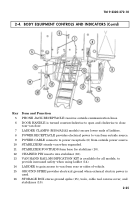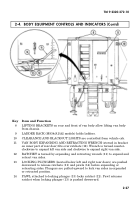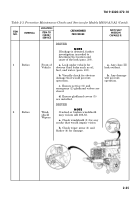TM-9-2320-272-10 - Page 131 of 481
TM 9-2320-272-10
2-32
Wetness around seals, gaskets, fittings, or connections indicates leakage. A stain
also denotes leakage. If a fitting or connector is loose, tighten it. If broken or defec-
tive, report it. Use the following as a guide when referring to table 2-2, Fluid
Leakage Criteria for Tactical Vehicles:
a.
Class I.
Leakage indicated by wetness or discoloration not great enough to
form drops.
b.
Class II.
Leakage great enough to form drops, but not enough to cause
drops to drip from item being checked/inspected.
c.
Class III.
Leakage great enough to form drops that fall from the item being
checked/inspected.
2-9. CLASS LEAKAGE DEFINITIONS
2-8. CLEANING INSTRUCTION AND PRECAUTIONS (Contd)
Cleaning Materials Used to Remove
** After cleaning, apply grease (MIL-B-18458).
Surface
Rubber
Insulation
Tires
Wire Rope
Wood
Oil/Grease
Damp or dry rags.
Soapy water and
bristle brush.
Cleaning com-
pound and wire
brush.
Detergent, warm
water, and damp
or dry rags.
Salt/Mud/Dust/Debris
Damp or dry rags.
High pressure water and
bristle brush.
Wire brush.
Low pressure water,
soapy warm water, and
damp or dry rags.
Surface Rust/Corrosion
Not applicable.
Not applicable.
Wire brush and lubricat-
ing oil.**
Not applicable.
Table 2-1. General Cleaning Instructions (Contd).
WARNING
Accidental or intentional introduction of liquid contaminants into
the environment is in violation of state, federal, and military regu-
lations. Refer to Lubrication Order (para. 3-1) for information con-
cerning storage, use, and disposal of these liquids. Failure to do so
may result in injury or death.
Back to Top




















